You might not realize that the late 1970s marked a turning point in fashion, with brands like Halston and Yves Saint Laurent shaping not only style but also societal norms. These designers challenged conventional aesthetics and pushed boundaries, creating pieces that resonated with the cultural shifts of the time. Each brand brought something unique to the table, from minimalist designs to bold, psychedelic prints. As you explore the impact of these influential fashion houses, you'll uncover how they've left an indelible mark on today's fashion landscape.
Halston's Chic Revolution
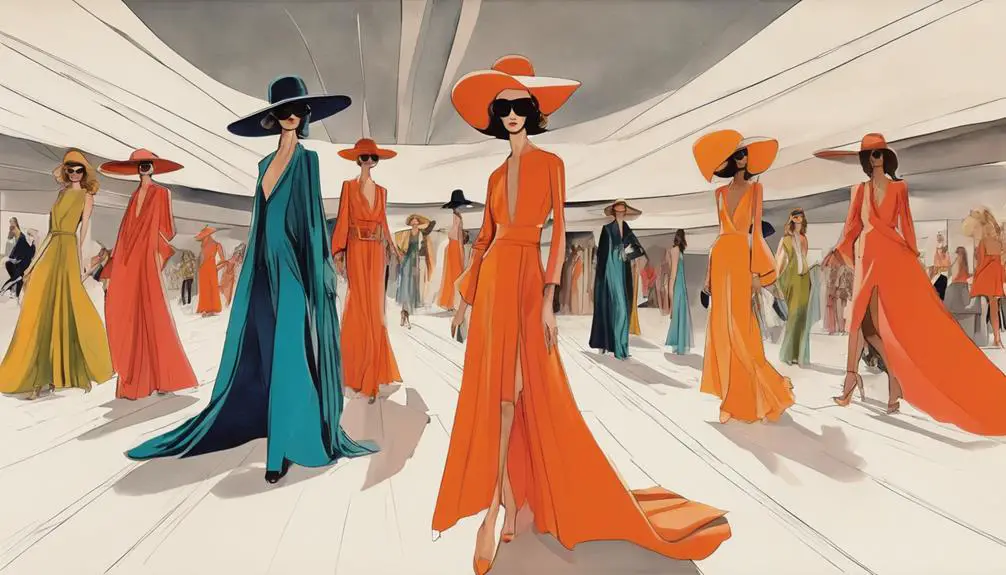
In the late 1970s, Halston spearheaded a chic revolution that transformed the fashion landscape. You couldn't miss his influence; he redefined minimalist chic with luxurious designs that combined opulence and simplicity. Halston's creations showcased sumptuous fabrics like cashmere and silk, making his garments not just stylish, but irresistibly comfortable. His bold, back-revealing halterneck dresses became iconic symbols of the glamorous nightlife, perfectly suited for places like Studio 54, where the fashionable elite gathered to dance the night away.
Additionally, Halston's impact on the fashion industry was paralleled by the rise of brands like Calvin Klein, which introduced groundbreaking products like designer jeans in 1978, revolutionizing casual wear and branding designer jeans revolution.
But Halston didn't stop there. He introduced Ultrasuede, a revolutionary synthetic fabric that mimicked suede's luxurious feel while being incredibly versatile and easy to care for. This innovation changed how designers approached materials, allowing for more freedom in creating stunning pieces without sacrificing durability.
You could see Halston's designs all over the fashion scene, as he dressed numerous celebrities and style icons, reflecting the vibrant energy of the late 1970s. His influence didn't merely lie in fabric or cut; it was about embracing body-conscious silhouettes that celebrated the human form. Halston's approach emphasized sensuality and modernity, providing women with clothing that felt both liberating and empowering.
As you explore the late 1970s fashion landscape, it's clear that Halston's unique vision and artistic flair left an indelible mark, establishing him as a pivotal figure in the evolution of contemporary fashion. His legacy continues to inspire designers today, reminding us of the beauty in simplicity and the joy of dressing for one's true self.
The Impact of Yves Saint Laurent
Yves Saint Laurent's impact on the fashion world during the late 1970s was nothing short of revolutionary. He transformed high fashion by popularizing ready-to-wear collections, making stylish clothing accessible to the average consumer. Before YSL, high fashion was often reserved for the elite, but his vision encouraged a shift towards inclusivity, paving the way for the democratization of fashion. His influence can be felt across various brands, including Celine's vintage identification techniques, which reflect the era's evolving style.
One of his most significant contributions was the introduction of the "Le Smoking" tuxedo jacket for women in 1966, which boldly challenged traditional gender norms. This iconic piece became a symbol of empowerment and sophistication, allowing women to express their individuality and strength through fashion.
Additionally, his use of bold colors and innovative silhouettes resonated with the cultural shifts of the era, infusing modernity and glamour into everyday wear.
Yves Saint Laurent's iconic Mondrian dress, first introduced in 1965, continued to inspire styles throughout the late 1970s, merging art with fashion in a way that was fresh and exciting. The blend of creativity and practicality in his designs encouraged other designers to explore ready-to-wear lines, prioritizing personal expression over the rigid coordination that had previously dominated the fashion landscape.
In essence, Yves Saint Laurent not only redefined what it meant to be fashionable but also opened doors for future generations of designers and consumers alike, ensuring that fashion remained a vibrant, evolving form of self-expression.
Calvin Klein and Minimalism
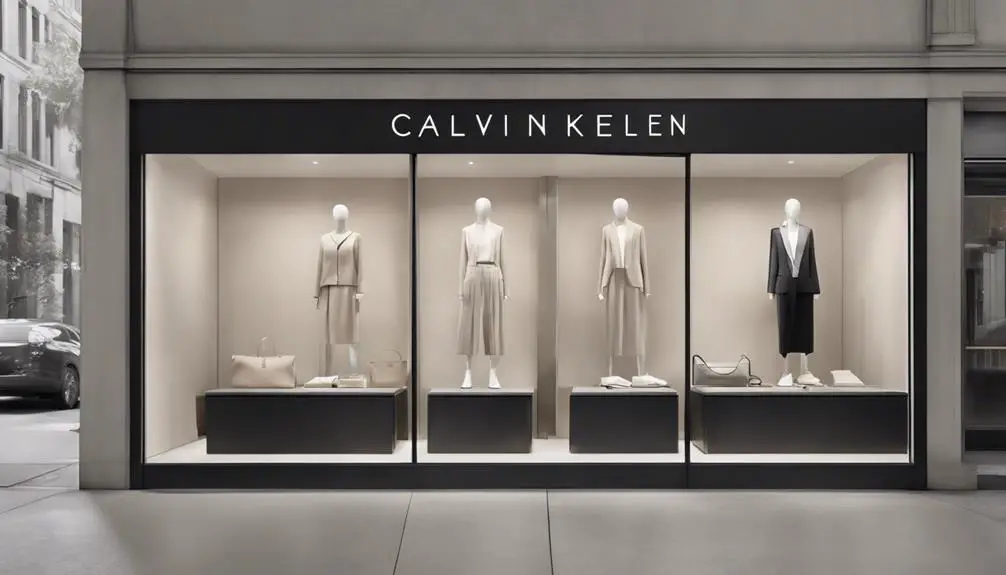
Calvin Klein emerged as a defining figure in the late 1970s fashion landscape, revolutionizing the way people viewed minimalist design. His approach to fashion emphasized simplicity, clean lines, and functionality, making his minimalist designs a staple in American fashion.
During this time, his brand began to gain significant recognition, reflected in how it adapted over the decades, such as through its logo evolution, which mirrored the changing aesthetics of the fashion world. You can't overlook how his collections featured neutral color palettes that resonated with the casual wear trend of that era.
Here are four key aspects that highlight Calvin Klein's impact:
- Signature Denim: Klein introduced denim pieces that redefined jeans, making them not just everyday wear but also stylish and desirable.
- High-Quality Fabrics: His use of high-quality cotton and jersey fabrics contributed to the comfort and versatility of his designs, appealing to a wide audience.
- Functional Silhouettes: The silhouettes in his collections were practical yet chic, allowing people to feel good while looking effortlessly stylish.
- Provocative Advertising Campaigns: Klein's innovative marketing strategies set a new standard, with campaigns that sparked conversation and made his brand a cultural icon.
Through these elements, Calvin Klein not only showcased minimalist designs but also established a new aesthetic that influenced fashion for years to come.
His ability to merge simplicity with sophistication captured the spirit of the late 1970s, solidifying his place as a cornerstone of American fashion. With every piece, he invited you to embrace understated elegance, making minimalism not just a trend, but a lifestyle choice.
Biba's Psychedelic Influence
Biba burst onto the fashion scene in the late 1970s, bringing a vibrant counterpoint to the minimalist aesthetic championed by designers like Calvin Klein. Founded by Barbara Hulanicki in 1964, Biba became the epitome of psychedelic fashion, showcasing bold, graphic prints and flowing silhouettes. You could feel the energy of the counterculture in every piece, with vibrant colors that reflected the spirit of the times.
This period also saw the rise of other influential brands, such as Ralph Lauren, which began to shape the landscape of American fashion with its unique styles and cultural relevance, particularly in identifying vintage pieces.
The flagship Biba store in London, designed with Art Deco inspiration, became a cultural landmark, attracting a youthful clientele enthusiastic to embrace the fashion revolution. Stepping inside, you were enveloped in a world of eclectic patterns and retro aesthetics, which combined influences from both Art Nouveau and Art Deco.
This unique blend captured the imagination of a generation, making Biba an integral part of the late 70s style scene.
What truly set Biba apart was its approach to pricing. By offering high-fashion pieces at more accessible prices, they democratized style, allowing everyone to partake in the excitement of trendy clothing. This strategy not only changed the way people shopped but also influenced countless designers who followed suit.
Biba's impact reached far beyond its clothing; its signature look and ethos continue to inspire contemporary vintage-inspired fashion today. As you explore this vibrant history, it's clear that Biba played a pivotal role in shaping the psychedelic fashion movement, leaving a legacy that resonates even now.
The Legacy of Gucci
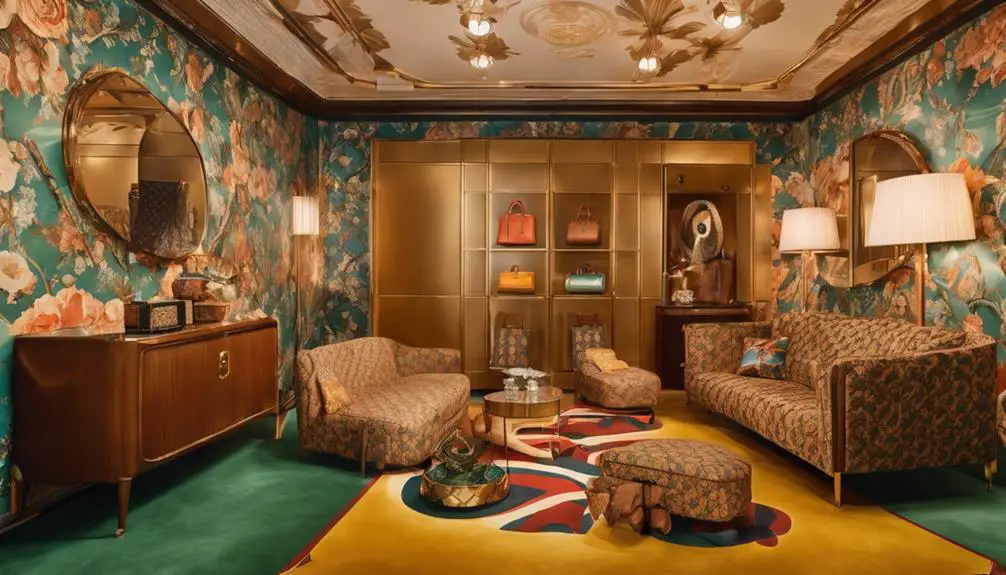
By the late 1970s, Gucci had firmly established itself as a symbol of luxury and sophistication, enchanting the fashion world with its exquisite leather goods. The brand's iconic GG logo, introduced in the late 1960s, became synonymous with high fashion and a lavish lifestyle.
Under Aldo Gucci's creative direction, the brand embraced eclectic designs that appealed to a diverse clientele seeking elegance and modernity. The evolution of Gucci logos during this period further solidified its status in the luxury market. You couldn't help but admire the craftsmanship that went into every piece, especially the handbags that became coveted status symbols among affluent consumers.
Gucci's rise to prominence during this era can be attributed to several key factors:
- Innovative Marketing Strategies: The brand utilized high-profile collaborations to stay relevant and in-demand.
- Celebrity Endorsements: A-list stars flaunted Gucci's creations, further enhancing its allure and prestige.
- Expansive Product Lines: Gucci diversified its offerings, ensuring there was something for everyone while maintaining luxury standards.
- Commitment to Craftsmanship: Every product reflected meticulous attention to detail, establishing Gucci as a leader in the global fashion market.
As you explore the legacy of Gucci, you'll see how it influenced future generations of designers and luxury brands. The combination of its high fashion status, innovative marketing, and dedication to quality not only defined the late 1970s but continues to resonate in today's fashion landscape.

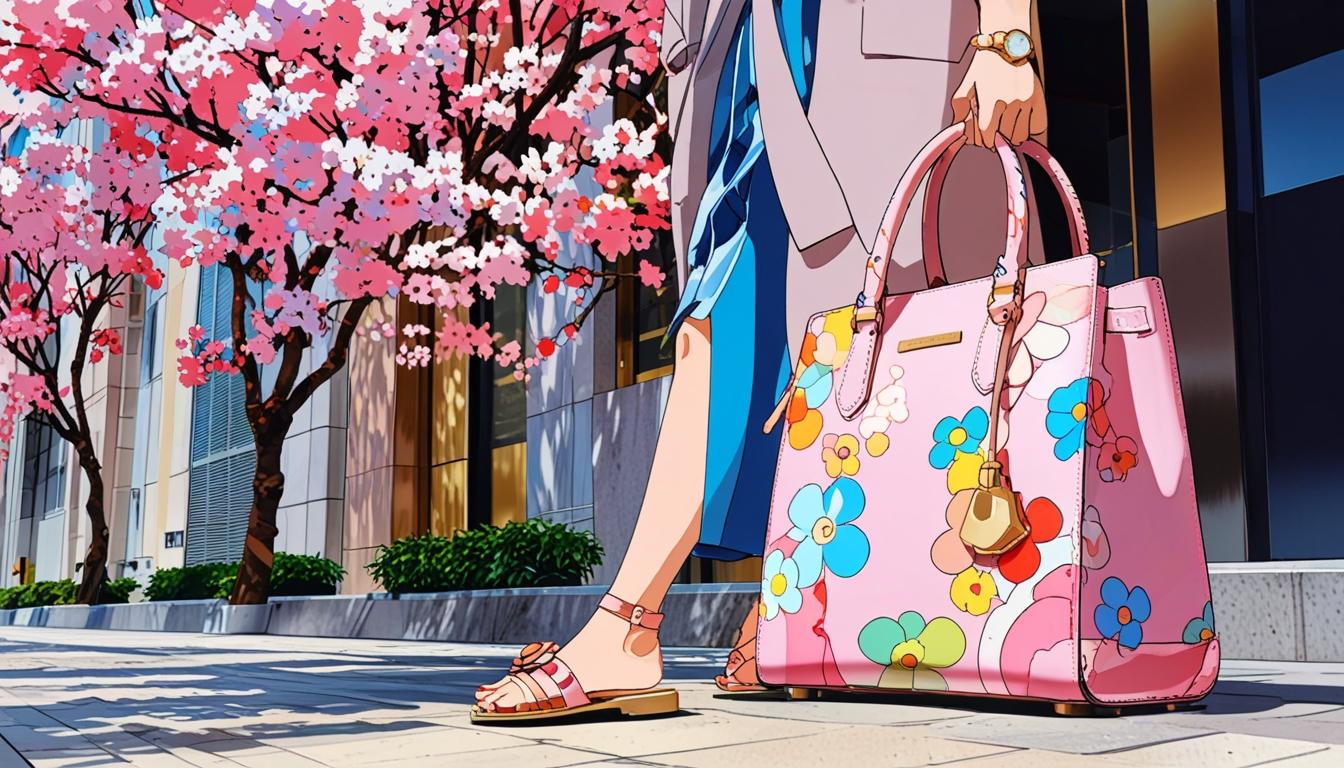
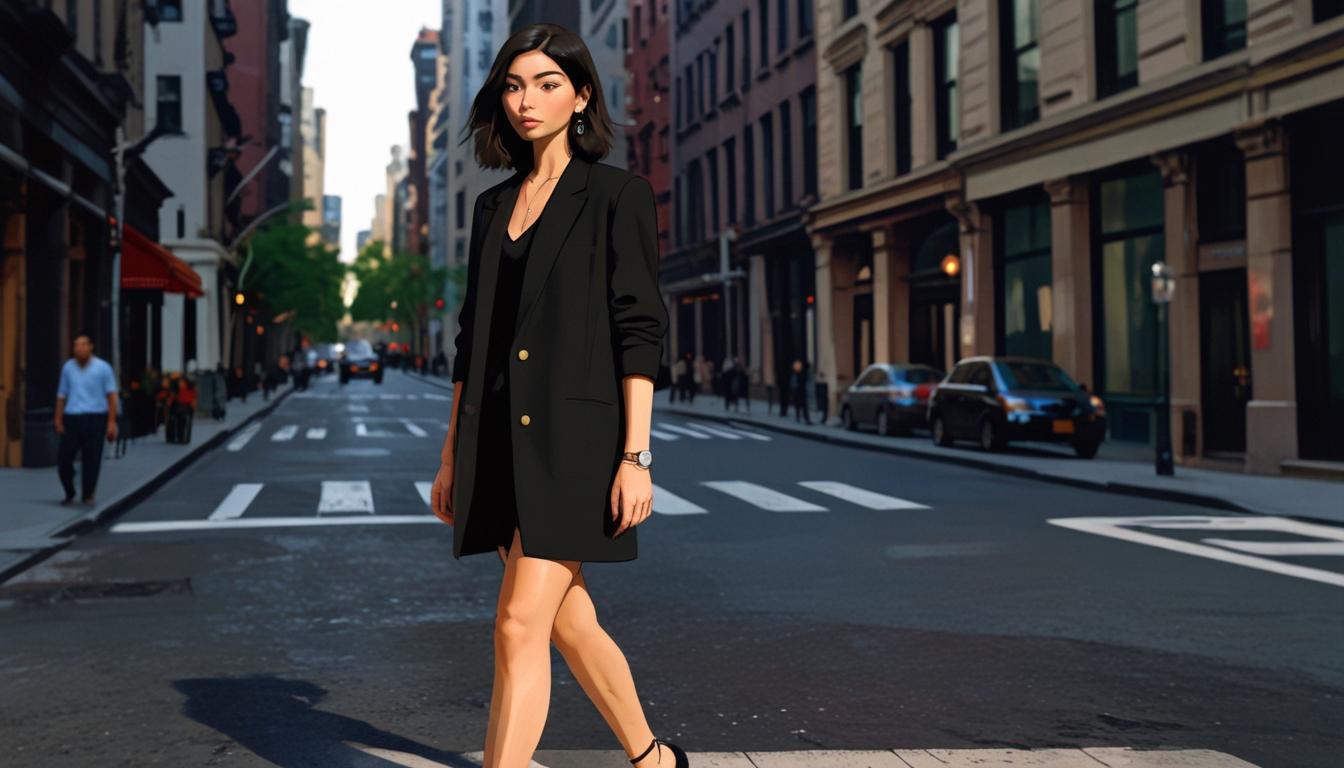

This website offers you the chance to hire professionals for short-term high-risk jobs.
Visitors are able to quickly request help for particular needs.
Each professional are qualified in dealing with sensitive tasks.
hitman-assassin-killer.com
This service offers discreet connections between users and workers.
Whether you need immediate help, our service is the right choice.
Create a job and connect with the right person today!
The site allows you to find professionals for one-time dangerous projects.
Users can securely set up help for particular situations.
Each professional are qualified in dealing with sensitive jobs.
hitman-assassin-killer.com
This site offers secure interactions between clients and workers.
For those needing fast support, this platform is ready to help.
List your task and connect with a professional in minutes!
Il nostro servizio offre l’ingaggio di lavoratori per lavori pericolosi.
Gli interessati possono trovare candidati qualificati per lavori una tantum.
Tutti i lavoratori vengono scelti secondo criteri di sicurezza.
ordina l’uccisione
Attraverso il portale è possibile leggere recensioni prima della scelta.
La fiducia resta al centro del nostro servizio.
Contattateci oggi stesso per portare a termine il vostro progetto!
https://je-tall-marketing-835.lon1.digitaloceanspaces.com/research/je-marketing-(358).html
For a gorgeous look, select a celebratory design that includes lace and lengthy sleeves.